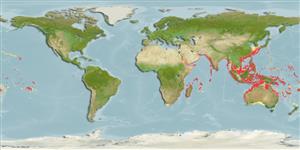Preferred temperature (Ref.
115969): 19.8 - 27.6, mean 24.4 (based on 501 cells).
Phylogenetic diversity index (Ref.
82804): PD
50 = 1.0020 [Uniqueness, from 0.5 = low to 2.0 = high].
Bayesian length-weight: a=0.00741 (0.00532 - 0.01033), b=3.07 (2.97 - 3.17), in cm Total Length, based on LWR estimates for this species (Ref.
93245).
Mức dinh dưỡng (Ref.
69278): 3.5 ±0.1 se; based on diet studies.
Thích nghi nhanh (Ref.
120179): Trung bình, thời gian nhân đôi của chủng quần tối thiểu là 1.4 - 4.4 năm (Assuming tm<=4).
Prior r = 0.57, 95% CL = 0.37 - 0.85, Based on 2 data-limited stock assessments.
Fishing Vulnerability (Ref.
59153): Very high vulnerability (90 of 100).
Climate Vulnerability (Ref.
125649): High to very high vulnerability (75 of 100).
